

Rotational power training: the foundation for all athletic power
Jason Krantz explains how to improve your total body power and sports performance with rotational power training.
All athletic movements involve a rotational component, either creating twisting movements through concentric muscular contractions (baseball swing, shot put) or resisting rotational movements/stabilizing the torso through isometric contractions. The ability to concurrently generate and transfer power in the torso originates from the core. The core includes the muscles of the abdominals, lower back, pelvic floor, and hips. In the simplest terms: rotational training = core training = total body power training.
Below are some examples of how enhanced rotational strength and power improve total body power and athletic performance in different types of sports.
1. Straight-line sprinting
Greater mechanical efficiency and better power transfer from arms/core to legs and ground due to a stable torso - the result: faster times and longer jumps.
2. Change of direction in sports (soccer, football, basketball, etc.)
Greater lateral agility and change of direction ability, along with improved acceleration and better body control in the air. The result: getting that one-step jump on the opponent, which is most often the difference between winning and losing.
3. Stationary sports (golf, baseball swing)
Increased hitting power. The result is hitting the ball harder and farther. It should be noted that excellent agility is a critical trait in most sports, such as football, soccer, basketball, and tennis. Discussing the training of agility is beyond the scope of this article, but a solid core serves as a great foundation from which agility can be improved.
How we develop rotational sport-specific power
It is usually assumed that strength training is the best way to increase both general and sport-specific power. The idea is that any incremental strength gains in the weight room will transfer directly and completely to the athletic playing field. Classic Olympic-style lifts, such as the squat, power clean, and snatch, are great movements for developing general, total body linear strength and power. However, these lifts in no way replicate the way power is developed in most athletic movements (Shepherd 2004; Siff et al. 1998)[1,2]. I remember a conversation with my track coach during my freshman year of college. I asked him why we did not spend more time in the weight room doing heavy squats and other "traditional" conditioning exercises. He said:
- "Why would we spend 50% of our time training movements that we might use for only 1% of your race? We are going to focus our efforts on the things that will make you a better and faster sprinter."
- "They don't hand out medals for bench and squat at the finish line of the 100 meters. They hand medals to the fastest runners. The clock does not care how much you lift."
Certain exercises work much better than others do when it comes to enhancing athletic performance. The key is to determine which exercises most closely match the power demands of a particular sport/event.
Is there a large initial load to overcome, as with a down lineman in American Football? Is it the only form of resistance, gravity and body weight, as with a sprinter? Is the movement executed from a stationary position, as in the golf swing? The answers to these questions give you a great idea of the types of movements the athlete should be focusing on in their power training sessions. This helps transfer those base power gains in the weight room into greater functional athletic power.
Rotational Power Development Exercises
These exercises improve explosive power in all athletes because all athletic movements involve some degree of twisting/stabilization. Think of these rotational exercises as fundamental power movements for any athlete. As such, their value in any complete training program is very high and will prove very useful, especially during pre-competitive and competitive seasons, to maximise power output.
Exercise Guidance
- Athletes should have a solid conditioning base before attempting these movements. These exercises are not intended for untrained athletes. The benefit of these power exercises is greater when one masters basic pulling, squatting, pushing, and rotational movements.
- The farther away you hold the weight from your body, the more challenging the exercise will be.
- It is important to start all exercises slowly. As your proficiency and technique improve, you will increase the speed and intensity of the exercise.
- Keep a good balance and posture while performing these exercises.
- Keep your hips stationary while fully rotating your shoulders during any rotational movement. This develops dynamic flexibility in the torso, which is crucial to help build and transfer power from the core to the arms, especially in throwing and hitting movements.
Russian Twist
Training Benefit
This exercise closely replicates the upper-body/shoulder rotation movements used in several different throwing and hitting movements. The one "limiting" factor of this exercise to take into consideration is that it is performed from a sitting position. Most rotational power training exercises should be performed from a standing position to replicate the body position demands of the sport as closely as possible during training (Siff et al. 1998; Baechle et al. 2008)[2,5].
Directions
- Sit on the floor with your knees bent at 90º degrees. Get a partner to hold your ankles to anchor the lower body.
- Holding a medicine ball or a lightweight, lower your torso to about a 130º angle. From this position, rotate from left to right while touching the ball/weight to the floor.
- Repeat for the specified number of reps.
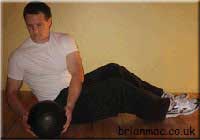 |
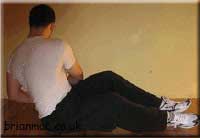 |
Cable Chop/Reverse Cable Chop
Training Benefit
These are two of my favourite exercises. These exercises are excellent at strengthening the transverse, internal, and external obliques and the spinal muscles of the core. Since these exercises are performed from a standing position, they are also excellent at connecting the various muscle chains from the feet to the hands.
Directions for the cable wood chop
- From a standing position with the feet shoulder-width apart, grasp the rope attachment, which is connected to a cable pulley.
- From this position, accelerate the rope diagonally down towards the floor while rotating the torso. Imagine trying to chop a piece of wood on the side away from the body.
- Return the rope slowly to the start position and repeat for the specified number of reps. Repeat for the left side of the body once the right side is complete.
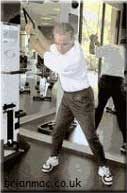 |
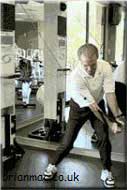 |
Directions for the reverse cable chop
- Performed the same way as the Cable Wood Chop, except instead of starting from a high pulley position and chopping down, you start from a low pulley position and chop up.
- Imagine trying to throw the rope over the shoulder that is opposite the cable.
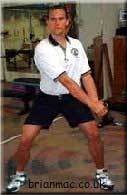 |
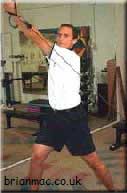 |
Super setting these two exercises is an effective way to increase rotational power and link together various muscle chains.
Standing Trunk Twist
Benefits
This exercise trains the entire core area and develops the dynamic stability and balance that is needed to maintain control of the athlete's centre of gravity once power levels increase. This is one of the exercises where the speed of movement can be high without the risk of injury. As this rotational exercise is performed from a standing position, the improvements from this exercise transfer well to the playing field.
Directions
- From a standing position with feet, shoulder-width apart, hold a weight or medicine ball straight out at shoulder height.
- From this position, rotate to the right. Once you have turned as far right as possible, reverse direction and rotate to your left until you cannot rotate left any further. Repeat for the specified number of reps. Try to maintain a wide arc with your arms and the weight.
- Lightweights (2 pounds for beginners, 4-6 pounds for advanced trainees) should be used for this exercise. I have seen individuals try this exercise with a 35-pound plate, and it completely negates the rotational power-enhancing training effect this exercise can offer. Not to mention, they drastically increase their chance of injury.
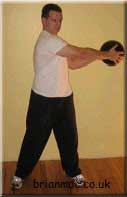 |
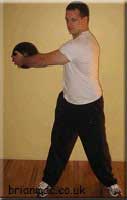 |
Medicine Ball Tosses
Medicine ball tosses are an excellent plyometric training strategy to maximise rotational power and overall total body power. These movements take advantage of the stretch/reflex mechanism to develop and release greater energy from muscles.
Modified Hammer Throw
Directions
- Start with your back facing the wall; feet shoulder-width apart, holding the medicine ball near your hip opposite to the throwing side.
- Transfer weight to the throwing side leg.
- Finish by throwing the ball at shoulder height with weight evenly balanced over the delivery leg.
- Catch the ball on the rebound and repeat the motion for the specified number of reps.
- Repeat for the other side.
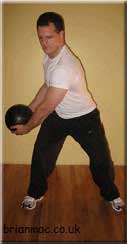 |
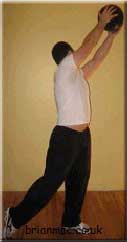 |
Side Throws
Directions
- Start with shoulders perpendicular to the wall, left shoulder closest to the wall. Place feet shoulder-width apart.
- Hold the medicine ball and rotate away from the wall by 90º, placing the ball behind the hip.
- Rotate forward to throw the ball into the wall. Deliver the ball at hip height with more weight on the front foot.
- Catch the ball on the rebound and repeat the motion for the specified number of reps. Repeat for the right side.
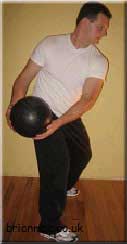 |
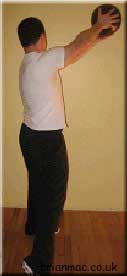 |
Wall Chop
Directions
- This exercise requires a medicine ball with a rope attachment or a medicine ball placed inside a towel.
- Stand about 2-3 feet away from a wall, with your back to the wall, and place your feet about shoulder-width apart.
- Holding the rope/towel with two hands, rotate to one side and swing the ball into the wall. Be prepared for a very fast kickback once the medicine ball springs back.
- Be prepared to swing immediately into another chop to the other side. This exercise should be one smooth, continuous motion until the prescribed number of reps is completed.
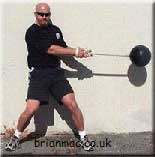 |
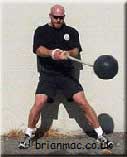 |
General rotational power training tips
Power training comes first
The order in which power exercises are performed is as important as the actual exercises that are selected. Perform these movements near the beginning of your workout when you are fresh and execute them with maximum effort for the greatest impact (Behm & Sale 1993; Cronin et al. 2001)[3,4].
The technique is priority #1
Initially, focus on developing good form. You can progress to heavier medicine balls after 4-6 weeks. The key is to train smart. Learn proper technique first, and then focus on speed or resistance.
Train with eyes closed
For a change of pace, perform these exercises with the eyes closed to train spatial awareness, dynamic balance, and enhance proprioceptive feedback.
Focus on balance
As rotational power levels increase, a significant amount of time and effort should be put into improving dynamic balance and awareness of where the athlete's centre of gravity is.
For the best power workouts, keep them short
When performing power training movements, keep workouts short (under 60 minutes). As fatigue sets in, the technique will suffer. If an athlete is power training in a fatigued state, it will lead to altered form, altered neural firing patterns, reduced power output, and decreased performance (Siff et al. 1998)[2].
Combine with other types of training
It is best to combine these rotational power exercises with various types of total body (both heavy and light) training stimuli at varying velocities to fully develop the muscular, neuromuscular, and proprioceptive coordination that will improve functional performance, rotational power, and total body power (Cronin et al. 2001)[4].
Do not undervalue mental energy
Performing technical and power work requires a fresh, focused mind to achieve the best results. Power training benefits from an energized mindset because the increase in mental energy will boost the flow of impulses from the brain to the muscles, thereby generating more power.
Perform a sport-specific warm-up
This will help reduce the risk of injury, awaken the nervous system, and increase the power available in both general and sports-specific movements.
Conclusion
These tips and exercises will improve the quality of your core and rotational training. With continued effort and suitably focused training, the result will be stronger, more powerful athletic movements and better performances.
Article Reference
This article first appeared in:
- KRANTZ, J. (2007) Rotational power training: the foundation for all athletic power. Brian Mackenzie's Successful Coaching, (ISSN 1745-7513/ 39/ February), p. 5-8
References
- SHEPHERD, J. (2004) Building Rotational Power: All You Need To Know About Getting In Shape To Perform Zippy Turns On The Hoof, Peak Performance, 197, p. 4-6
- SIFF, M. and VERKHOSHANSKY, Y. (1998) Supertraining: Strength Training for Sporting Excellence. Johannesburg, South Africa: University of the Witwatersrsand
- BEHM, D.G. and SALE, D.G (1993) Intended rather than actual movement velocity determines velocity-specific training response. J. Apply.Physiol. 74, p. 359-368
- CRONIN, J. et al. (2001) Velocity specificity, combination training and sport specific tasks. J. Sci. Med. Sport. 4, p. 168-178
- BAECHLE, T.R. and EARLE, R.W. (2008) Essentials of Strength Training and Conditioning. 3rd ed. Champaign, IL: Human Kinetics Publishing Company
Page Reference
If you quote information from this page in your work, then the reference for this page is:
- KRANTZ, J. (2007) Rotational power training: the foundation for all athletic power [WWW] Available from: https://www.brianmac.co.uk/articles/scni39a3.htm [Accessed
About the Author
Jason Krantz is a Certified Strength and Conditioning Specialist (CSCS) and is recognized as part of an elite group of golf performance specialists in the USA. He has worked with golfers of various levels, from beginners to PGA Teaching Pros, to help maximise their power and overall golfing potential.